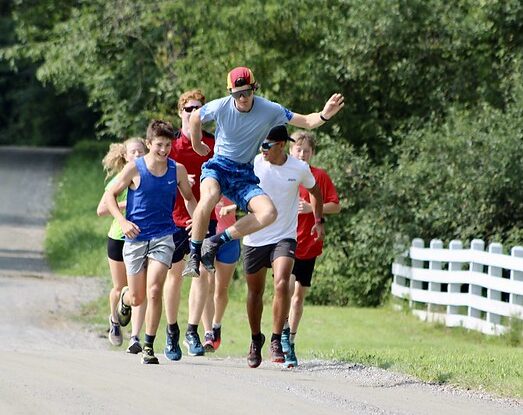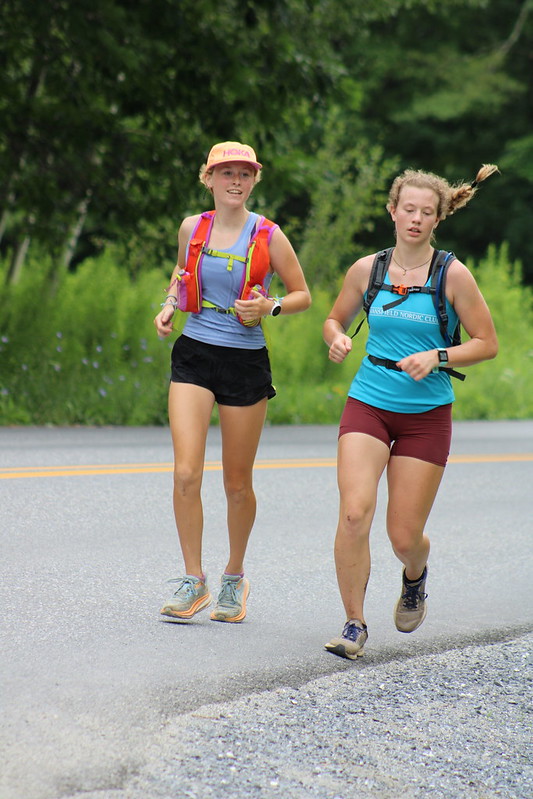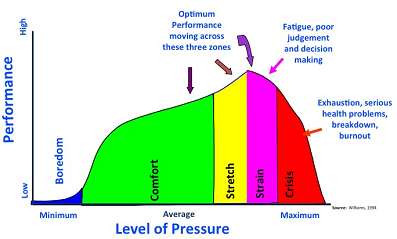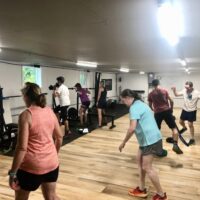The transition back to school brings a lot to the table. Early (and late) school days, homework, new teachers and peers, and big transitions like middle school -> high school all weigh heavily on the teenage mind!
Don’t forget to add fall sports into that mix, as preseason training often begins even before the bell rings and classes start. While our ski training involves a variety of stimuli such as rollerskiing, running, hiking, lifting, and cycling, the switch to a fall sports often means a much greater emphasis on single-mode training. One of my favorite aspects of Nordic skiing is that the off-season can be (and in fact should be) so varied. I truly don’t think I’d have made it this long as a coach if the sport I was involved in was simply running or cycling day-in and day-out.

MNC warmup before running intervals (4-5 x 1 mile) a couple weeks ago
For sports like XC running, there isn’t a lot of room for variation, especially at the high school level: while skiers in MNC have an entire year of periodized training volumes, tests, camps, and progression, high school coaches are essentially handed a group of athletes and only 6-8 weeks to try and help everyone race fast and achieve their goals.
It’s a position I don’t envy, because it makes it extremely hard to focus on anything other than the sessions that have the most direct impact on growth and performance. It almost certainly makes it harder to build a team culture and climate as well, since after school time is limited and there isn’t always room for extracurricular activities like stopping for pizza after a hike, or going to the driving range as a cooldown from intervals. Kudos to those teams with really awesome vibes, because it shows a real connection between coaches, athletes, and teammates!
So the net of all this? If you’re on a cross country team in the fall, you should expect to run…a lot. From my outside take (through training logs, practice schedules, conversations with athletes, etc) there are several big differences between MNC training in the fall, and XC running training in the fall. Some of these differences are physiological, and some are related to culture and attitude. Keep in mind these are only observations, but I think it would be beneficial for me to share my take:
PHYSIOLOGICAL
XC running workouts are often “short” when compared to MNC sessions. For us, running or rollerskiing for 90-120 minutes of on-time is pretty common. We base our training in hours, not mileage, and try to keep track of heartrates and pacing to ensure we are going very easy on the easy days, and hard on the hard days.

Julia and Elsa 18 miles into a trail run. This one was a few hours long, but the easy pace meant no problems!
For MNC, an easy distance run may be 10:00/mi pace and last 9 miles (or 7-8 miles if we’re on hilly, twisty trails) for a 90 minute session. A varsity XC running group may complete the same distance in 63 minutes (7:00/mi pace) or 67.5 minutes (7:30/mi pace). That’s almost a third less “on” time and, unless you have been working toward that pace all summer, a fair bit above a calm aerobic pace that allows for recovery…if you are running too fast on your easy days, it makes it tough to speed up on your hard days, such as intervals or races.
While a long run at fast paces may be tough on the body, some coaches might argue that a running team’s shorter days are in fact not long enough to provide a substantial benefit for a skier…running 3-5 miles at a pace of 7:30/mi means you may only be moving for 30 minutes total.
Racing every weekend in the fall can be a bit draining physically, as the body must constantly become activated and primed for each new competition. Often race days seem to involve bus travel, a very simple warmup, a race of 16-24 minutes, and a short-to-nonexistent cooldown. For most XC runners you are looking at almost every Saturday being under 60 minutes of active time unless you are taking additional steps to gain more from the race event (see below).
Finally, and what may seem most obvious and critical to many, is the schedule and training constraints that limit both rollerskiing and strength training in the midst of XC season. While some running coaches may eschew rollerskiing and lifting (we’re talking true strength training at a gym or home gym, not crunches and planks in a circle on the soccer field) in the season, these can be incredibly valuable sessions to include weekly, even in place of running as a way to avoid overuse injury, strengthen the muscles and joints against harm, and still get in a valuable training component.
Adam’s suggestions for runners (physiologically):
- Try to have your longer running workouts be at a slower pace! If you run a 21:00 5km and are doing your longer and “easier” runs at 7:30 pace, you aren’t far off hitting your race pace outside of the races and hard days themselves. Don’t fall into the trap of racing every workout or run, and be ok with going a pace you feel is easy, conversational, and manageable to recover from. Save your fast miles for interval workouts and races.
- Avoid pavement! If you have the option to ask a coach, or if you’re a captain that can choose some routes, try to stick to trails, gravel, dirt roads, and paths. Most of us have not been running on pavement during the summer months, and there’s nothing like a hard surface to induce soreness, injury, and fatigue.
- Look for ways to make your race days structured, and don’t be afraid to use them as an opportunity to work on your warmup and cooldown processes. Instead of just walking the course, jog lightly and include some pickups on technical sections like corners and downhills. Bring a mini band and activate the hips and glutes like you would before MNC running intensity. Spend some time in L3 as we try to do when previewing a ski course. If you can make your warmup 25-30 minutes of focused running, and extend your cooldown to be 25-30 minutes of very easy jogging after your race, your body will gain more from the day AND likely feel better faster!
- Try to find time for at least 1 rollerski workout each week, and 2 strength sessions. In both cases aim for an upper body focus (like double poling or V2 work) but when it comes to strength, don’t skimp on seemingly-easy exercises like calf raises, hops, and glute/adductor/hip exercises that strengthen the body against running injuries! A great time for a rollerski may be Saturday afternoon once you have rested and recovered a bit from a running race: this enables you to get some ski time in, build active recovery from the race effort, and still leave Sunday as a total off day (if you have training on Monday).
PSYCHOLOGICAL
Races are tough! They aren’t just tough on your body, but your mind as well. It takes a lot of mental energy to find the right level of activation for a race…positive mindset, focused energy on pacing and performance, and determination to endure the pain of a hard effort…these don’t come about for free!
There is a very famous chart/theory from Yerkes-Dodson which lays out the way the mind becomes “activated” (ready to race) before an event:

With races nonstop from September right into ski season (which is even longer, with races starting in late Nov/early Dec and going into March) it means a lot of repeated climbs up this pressure/performance curve. Later here I’ll talk about some ways to keep perspective and avoid wading into the “stretch/strain/crisis” side of this graph!
Racing also comes with team pressure. While both skiing and running are often called “individual” sports, they are so much better with a team! Team dynamics at their best can be motivating and fun, pushing everyone to perform their best and work hard. However when the pressure to win a competition, place ahead of a certain rival team, or compare one group to another gets out of hand, it can have a detrimental effect.
Adam’s suggestions for runners (psychological):
- Try to set smaller goals for individual races related to the course, the warmup, the sensations you’re aiming for, etc…outcome goals (like a time or place) are great periodically, but try to focus on the process and not get too caught-up in chasing one time or place all season which can quickly lead to stress and over-reaching on the above curve of activation.
- Be a positive force for team cohesion! Think about the times you’ve felt supported by teammates or coaches, and try to relay those elements or embody them. Notice when other runners improve, or run their best times, rather than focusing on whether or not your team beat or lost to an opponent, and you’ll find yourself in a better mindstate with less stress before/during/after races!

Going hard can be fun!






